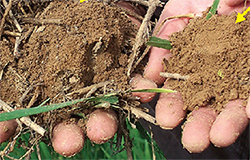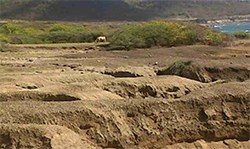Guide to land degradation assessments aims to help SIDS prosper

Small Island Developing States (SIDS) have it rough in many ways. They are perhaps best known for their vulnerability to climate change, as a result of high poverty, rural populations, dependence on traditional agriculture, tourism-based economies and other factors.
These same characteristics make land degradation an equally worrisome issue, creating knock-on effects on economic growth, human development and environmental sustainability.
To prevent land degradation from causing more problems – particularly to food security – it is crucial to know where it takes place, which type, at what intensity and how land users are addressing this problem through sustainable land management.
A new manual from FAO, Land Degradation Assessment in Small Island Developing States, provides a simple and structured way to pin down this vital information and allow interventions that will keep SIDS on the right development path.
“The causes of land degradation and its impacts on ecosystem services and livelihoods are often not fully understood,” said Eduardo Mansur, head of the Land and Water Division at FAO. “This guide can fill these knowledge gaps and allow us to design appropriate and effective responses.”
SIDS possess unique characteristics that further exacerbate problems associated with land degradation: small size (physical and economic), limited infrastructure, distance from large international markets, high vulnerability to natural disasters, and increasing urbanization.
 Their small size – combined with diverse soil types, topography, climatic variation, and lack of land-use policies – limits the area available for urban settlement, agriculture, mining, commercial forestry, tourism and other infrastructure, and creates intense competition between land-use options.
Their small size – combined with diverse soil types, topography, climatic variation, and lack of land-use policies – limits the area available for urban settlement, agriculture, mining, commercial forestry, tourism and other infrastructure, and creates intense competition between land-use options.
This means that even a small amount of land degradation can have large impacts.
Of the 400 ha of degraded land in SIDS worldwide, 120 ha occur in the Caribbean region, according to UN Environment’s Global Environment Outlook. In the SIDS of the Caribbean, and Latin America, land degradation costs an estimated US$4,800 million dollars annually, and impacts approximately 125 million people.
Yet land degradation in the SIDS of the Caribbean has been growing, driven by urbanization, climate change and poor land-management practices – such as slash and burn agriculture, uncontrolled livestock grazing on fragile lands, poor road construction and unplanned or poorly planned settlements in landslide-prone areas.
Land degradation is one of the root causes of declining agricultural productivity globally; if left uncontrolled, it will exacerbate the problems of food security within the region. Additionally, it hampers the capacity of SIDS to adapt to climate change.

The Land Degradation Assessment in Drylands (LADA) assessment methodology followed in the manual aims to deliver an understanding of the state and nature of change in land resources and ecosystems, the drivers and impacts of land degradation and sustainable land management, the impacts they have on ecosystem services and livelihoods, their resilience to climate change, and what applied approaches are proving successful.
This assessment approach, manual and associated training build on country knowledge and experiences and are expected to enhance the capacity of users to conduct more integrated and participatory assessments of land degradation, to monitor impacts of interventions or changes in land management more effectively, and to enhance informed decision-making for future investments.
